Page 335 of 352 pages « First < 333 334 335 336 337 > Last »
James Tobin
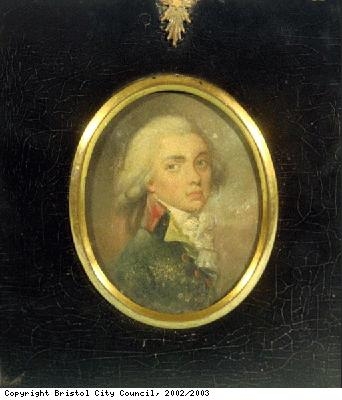
Description:
Miniature believed to be of James Tobin. Friend and business partner of the plantation owner and sugar merchant John Pinney. James Tobin, became a prominent campaigner against the abolition of the slave trade.
With thanks to Dr J Tobin for the use if this item.
Creator: unknown
Date: c. 1790
Copyright: Lent to Bristol Museum and Art Gallery
The Abolition of the Slave Trade
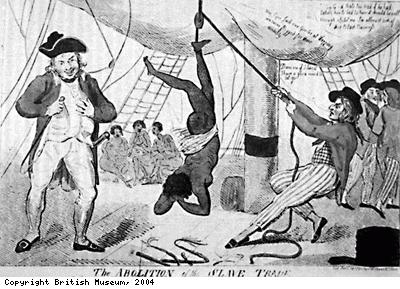
Description:
The Abolition of the Slave Trade, showing Captain John Kimber of Bristol flogging a slave girl because she was unwell and could not eat, by Isaac Cruikshank, 1792.
Copyright The British Museum
Creator: Isaac Cruikshank
Date: 1792
Copyright: Copyright British Museum
Miss Hannah More
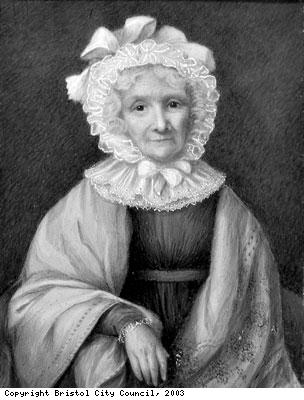
Description:
Watercolour on ivory painting of this influential Bristolian. She began her career as a playwright and founded a school for young ladies in Park Street, Bristol. She became an Evangelical Christian in her later years, establishing Sunday Schools, writing religious tracts and campaigning against the slave trade.
Creator: British School
Copyright: Copyright BCC Museum
Object ID:k4515
Anne Yearsley
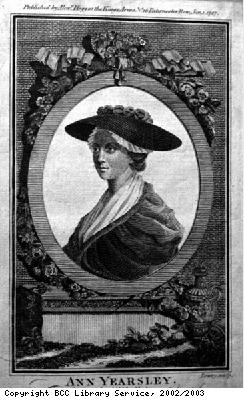
Description:
Portrait of Anne Yearsley, a famous Bristol poet. Amongst her writings were poems against Bristols trade in slaves.
Date: unknown
Copyright: Copyright BCC Library Service
Print of abolitionist and slave (detail)
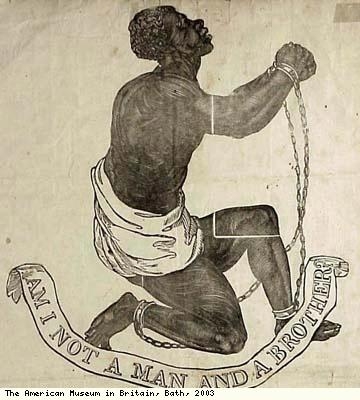
Description:
Detail of poster against the slave trade, produced by Abolitionists who campainged for the end of slavery (c. 1860).
The poster shows a kneeling figure of a slave in chains, with the words: Am I Not a Man and a Brother? Our Country Men in Chains, with verse by J G Whittier.
The poster may have come from an abolitionist Broadside (a propaganda Broadsheet against the slave trade).
The figure on this poster is the image of a kneeling black slave used by anti-slavery campaigners, or Abolitionists, as their logo. The kneeling slave is asking for help from his white brothers. This image was widely used to raise support and awareness for the campaign, it appears on many items, from pamphlets through to china plates.
The enslaved Africans were not as passive in their role as this symbol suggests, their continual fight against slavery was the main contributing factor to its abolition.
Contributed by John Judkyn Memorial.
Date: c. 1860
Copyright: The American Museum in Britain, Bath
Object ID:65.217(detail)
Brookes model
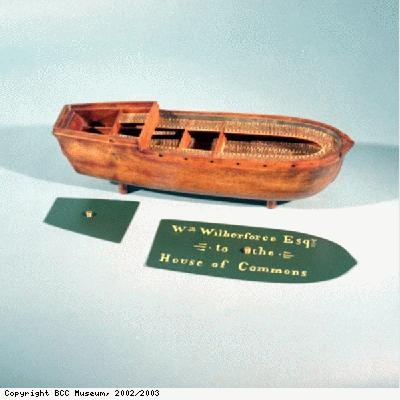
Description:
This is a copy of the model of a Liverpool slave ship called the Brookes. The original model was used by leading Abolitionist William Wilberforce in the campaign to end the slave trade. He used it to show how slaves were packed in the hold. It was sent to the House of Commons to show Members of Parliament the horror of the journey taken by the enslaved Africans accross the Atlantic Ocean.
Date: unknown
Copyright: Copyright BCC Museum
Thomas Clarkson

Description:
Painting: Thomas Clarkson, after a painting by A E Chalon, R A Thomas Clarkson was the driving force behind the campaign to end slavery, which began from a concern with the harsh conditions suffered by ordinary seamen on slaving voyages. He wrote and spoke about the need for abolition, and in researching his subject he came to Bristol in 1787. With the help of local Quakers and the landlord of the Seven Stars Inn, Clarkson interviewed many sailors and heard their stories of the horrors of slaving voyages. In 1823 he addressed the first meeting of the Bristol Auxiliary Anti-Slavery Society. At his feet is Clarkson’s Box, a collection of the products of Africa. He tried to show that African foodstuffs, dye plants and maunfactures, such as fine textiles, could replace the trade in slaves, to the benefit of both African and European traders.
With thanks to P A Houston for the use of this item.
Creator: Chalon
Date: late 18th century
Copyright: Lent to Bristol Museum and Art Gallery
Jasperware plaque
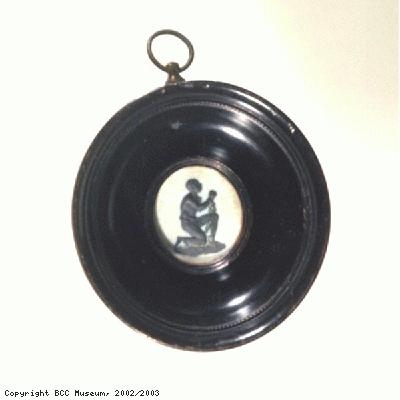
Description:
Am I not a Man and a Brother Jasperware plaque.Contributed by Josiah Wedgwood, a supporter of the Abolition
Creator: Wedgwood
Date: unknown
Copyright: Copyright BCC Museum
Abolition penny token
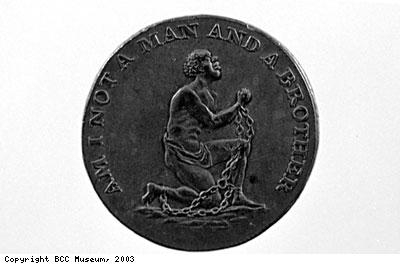
Description:
Abolition penny token.
The caption on the token reads AM I NOT A MAN AND A BROTHER?
The figure on this token is the image of a kneeling black slave used by anti-slavery campaigners, or Abolitionists, as their logo. The kneeling slave is asking for help from his white brothers. This image was widely used to raise support and awareness for the campaign, it appears on many items, from pamphlets through to china plates.
The enslaved Africans were not as passive in their role as this symbol suggests, their continual fight against slavery was the main contributing factor to its abolition.
Date: c. 1800s
Copyright: Copyright BCC Museum
Object ID:Bowles Coll 234
Pacification with the Maroons
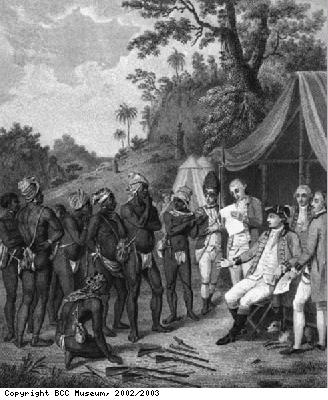
Description:
Engraving on paper called, Pacification with the Maroon Negros, by Agostino Brunyas. The Maroons were runaway slaves who established independent communities. In Jamaica, the original Maroons had run away from their owners when the British took the island from the Spanish in 1655. They built their homes in the mountains, and resisted recapture by the British for over 100 years. Following ten years of fighting, from 1730 to 1739 (the first Maroon war), the British accepted the situation and made a treaty with the Maroon community, giving them land and recognising their freedom. As part of that treaty, the Maroons pledged to recapture runaway slaves.
The language used to describe people of African descent in the 18th, 19th and 20th centuries is unacceptable in today’s terms. We cannot avoid using this language in its original context. To change the words would impose 20th century attitudes on history.
Creator: Agostino Brunyas
Date: 1801
Copyright: Copyright BCC Museum
Page 335 of 352 pages « First < 333 334 335 336 337 > Last »

